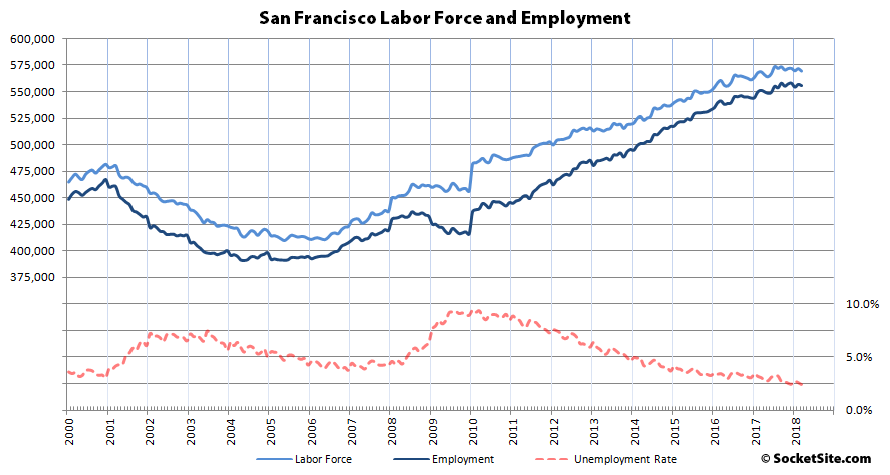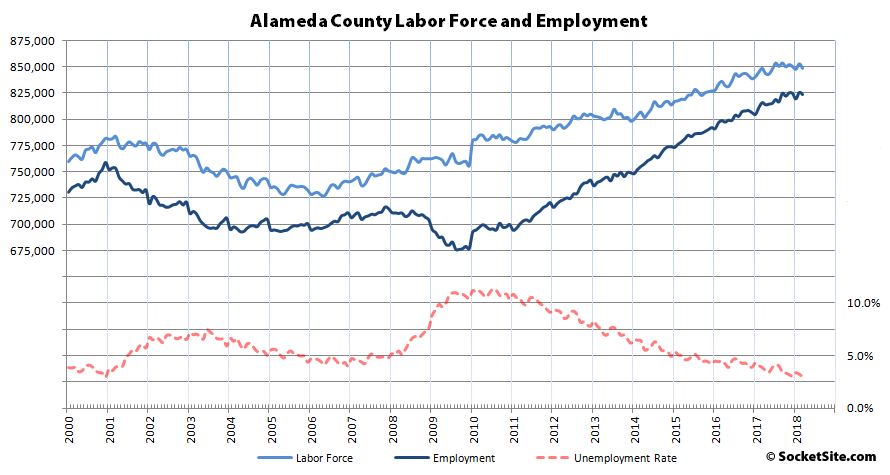At a time of the year when Bay Area employment figures typically tick up, the number of people living in the city of San Francisco with a job dropped by 1,200 in March to 555,500. But with 2,300 people having been removed from the labor force, the unemployment rate actually dropped to 2.4 percent from 2.6 percent in February.
And while there are still 90,000 more people living in San Francisco with paychecks than there were at the end of 2000, an increase of 118,800 since January of 2010, the year-over-year increase of 4,400 last month was the smallest growth rate since 2009.
In Alameda County, which includes the City of Oakland, the estimated number of people living in the county with a paycheck slipped by 2,000 to 823,900 in March, which is still 7,700 more than at the same time last year and a gain of 131,100 since the beginning of 2010, while the unemployment rate in the county dropped to 3.0 percent as the labor force contracted.
Across the greater East Bay, employment dropped by 3,400 to a record 1,370,700 while the unemployment rate dropped from 3.3 to 3.0 percent.
Up in Marin, the number of employed residents slipped by 800 to 137,500, which puts the unemployment rate at 2.3 percent.
And down in the valley, employment in San Mateo County slipped by 1,000 to 442,900, which is still 3,600 higher than at the same time last year with an unemployment rate of 2.2 percent, and the number of employed residents in Santa Clara County dropped by 3,300 to 1,019,900 in March, which is still 19,500 more than at the same time last year with an unemployment rate of 2.6 percent.


Qualcomm just announced a fairly large layoff of 1500. While their headquarters are not here in the Bay Area, this will have a ripple effect on all tech. There are also quite a few merger possibilities simmering.
Qualcomm’s layoffs will have a bit of a direct effect here in the Bay Area too, as news reports say that 269 of the layoffs are happening in San Jose and Santa Clara.
If you squint, it might look like the Labor Force and Employment lines in that graph are leveling off, although it’s too early to tell.
There’s no need to squint. As we headlined last month: Employment Ticks up to (Mostly) Record Highs as Growth Slows. And as noted above, “the year-over-year increase [in San Francisco employment] last month was the smallest…since 2009.”
A total loss in March of over 8K jobs across the Bay Area. By contrast, the state of Washington – about equal in population to the BA – saw a jump of almost 4K jobs in March. Mostly concentrated in the Puget Sound area. Another point – much of the national job growth has been in tech and construction. Usually these two categories are significant drivers of BA job growth but those sectors seem to be cooling off in the BA.
The thing to note is the leveling of job growth since mid-2017 – not a jump one month and a decline the next. This at a time of solid job growth in other regions. Over the coming decade the BA will not get the lion’s share of job growth as it has in the past. For all the reasons that have been discussed here and for the fact that the region has not addressed those issues in any coordinated or effective way. The slowing/leveling job growth is paralleled by anemic population growth for the region. Part of a macro shift in job/population centers coming in future years.
The Bay Area can’t have much job growth, as our unemployment rate is shockingly low and we’re not building much new housing. We’re about maxxed out around here, which is lucky for spillover regions like Seattle.
Even if we built new housing, we’re maxed out on transportation infrastructure. In fact, we are well past maxed out.
I think everyone agrees that we should build better transportation infrastructure. Unfortunately our elected officials haven’t shown themselves up to the task.
At least Caltrain is being electrified.
Rent increases are far out pacing wage increases. Congestion is up. Commuting is sucking up more and more of peoples time. As the U-haul data shows – there is an exodus out of the Bay Area for places with lower costs, less stress, overall better quality of life.
We have had a good run – but growth has limits.
There’s an exodus out which is more than balanced by the exodus in. The Bay Area’s population keeps growing.
What is the basis for your data? Where is the primary source?